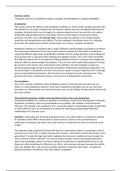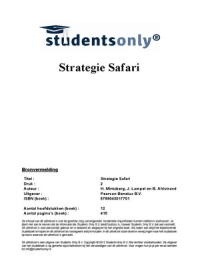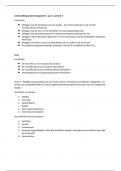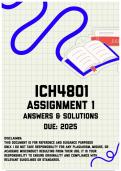‘Templates and turns in qualitative studies of strategy and management’ (Langley &Abdallah)
Introduction
This article is about the different ways qualitative methods are used to study strategy processes (the
how questions in strategic management), like decision making, learning, strategizing, planning and
changing. Qualitative data have strengths for understanding processes, because they can capture
temporally evolving phenomena in rich detail. The focus in this study is on the data of these
processes over time, also called process data. Process data incorporates a mix of observations,
memories and interpretations and artifacts. The key challenge in qualitative study isn’t collecting
these data, but making sense of them, because they are so messy, complex and eclectic.
Qualitative methods are associated with a range of different epistemological assumptions and these
have important implications for the way in which data are interpreted. The article contributes by
comparing different approaches of qualitative methods and also paying attention to the writing part,
because there this is a big part of the challenge of qualitative studies. Also, there will be described
four different approaches to do doing and writing qualitative research in strategy and management
based on different epistemological foundations. There are two well-established templates for doing
this and two more recent ‘turns’ that deserve more attention. The first template is based on a
positivist epistemology and aims to develop nomothetic (making laws) theoretical propositions. The
second template is interpretive and more concerned to capture and gain insight from the meanings
given to organizational phenomena. The two turns are a practice turn and a discursive turn. They
generate innovative contributions based on new ways of considering the social world.
Two templates
One of the common complaints about qualitative research is that the rules and norms are not
uniform or well-established. However, there have emerged two templates we can use, that both
have their own internal logics and rhetorical power (own way of writing): the Eisenhardt method and
the Gioia method.
The Eisenhardt template: credibly novel nomothetic theory from case comparisons
Eisenhardt establishes her method as positivist in orientation, aimed at the development of testable
hypotheses and theory which are generalizable across settings. The method is oriented toward
induction. The method is also inspired by Yin’s case study research, emphasizing a logic of replication
in which different cases are considered as occasions for verifying and elaborating theoretical
relationships from previous cases.
Induction = generating sets of formal propositions from case study evidence, presented as suitable
for situations where little is known about a phenomenon or where current perspectives are
conflicting or confusing, and where case study evidence can therefore be seen to contribute novel
insight.
The replication logic proposed by Eisenhardt requires a substantial number of comparative units of
analysis/cases (4-10). This is needed, because the research is about their common dimensions, to be
generalized. To make this logic work and to optimize the chances of credible and novel insight, the
cases cannot be chosen arbitrarily. You have to choose and gain access to promising phenomena
where new knowledge is likely to emerge, setting up comparisons to maximize differences on one
dimension while controlling for differences on others, and ensuring coverage of perspectives within
each case. Besides this, cases are also carefully selected to represent ‘polar types’: comparisons
between extremes. This leads to very clear pattern recognition.
, The credibility of those insights is enhanced by sampling multiple perspective within each case, for
example both buyers and sellers, or both managers and subordinates. Interviews tend to be the main
source of information, but there is also a strong emphasis on collecting several kinds of data. Finally,
tandem interviewing, electronic recording and rapid transcription are enhancing validity and
reliability. Then there is the analysis, which is described as a two-stage process, beginning with the
construction of complete within-case narratives and followed by iterative processes of case
comparison that continues until a set of constructs that explain similarities and differences in
outcomes emerge. After the analysis, the writing of the article follows.
Eisenhardt has perfected a distinct mode of writing case study articles. The most interesting
rhetorical feature is how each individual finding or proposition is argued in three key moves:
1. Establish novelty: explicitly drawing the contrast between what previous literature or theory
says and what the current findings are
2. Presentation of the evidence: by presenting an overall semi-quantitative portrait of the
evidence, supporting the proposed relationship in a table in which cases are ordered
vertically from more to less high performing. The columns of the table draw together
evidence.
3. Ask yourself why the observed relationships might hold. So not just offering evidence but
also give an explanation. Usually two or three reasons are offered for each proposition.
These propositions can be integrated together into a coherent theoretical story that reaches beyond
the individual components. This final step is important and can be challenging, because the need for
novelty and credibility must be maintained.
Overall, this method is a very successful approach to strategy process research, as many researchers
and authors use it now. But the template has also its boundary conditions and limitations. First, the
approach often leads to variance, rather than process theorizations. This means that the emphasis in
most applications is on explaining variation in outcomes, rather than on understanding patterns of
evolution over time. Multiple case analyses can be used for variance models, but the logic is different
than described above. Rather than seeking explanations for differences between cases, a process
theoretical analysis requires looking for regularities in temporal patterns across cases. A second
limitation concerns the degree to which the findings emerging from such studies are indeed as novel
and surprising as claimed. Finally, the Eisenhardt multiple case method is positivist in orientation, so
it attempts to access factual data about what happened and it aims to develop generalizable
nomothetic causal laws about objectively observable phenomena in the real world.
The Gioia method: interpretive modeling of informant understandings over time
Cross-case comparative studies and single case analyses have very different objectives and make
different kinds of theoretical contributions, valued for different reasons. One group of scholars who
appear to have perfected an approach for both doing and successfully publishing single in-depth
interpretive case studies is Dennis Gioia and his colleagues and students. Unlike Eisenhardt, Gioia has
never published a paper explicitly describing step by step his methodology. However, in a reflexive
piece about his career as an organizational scholar, he noted: In my research life, I am a grounded
theorist. I pick people’s brains for a living, trying to figure out how they make sense of their
organizational experience. I then write descriptive, analytical narratives that try to capture what I
think they know. Those narratives are usually written around salient themes that represent their
experience to other interested readers. This shows the interpretive philosophy that drives Gioia. Gioia
is interested in how people understand the change they are dealing with and how those meanings
evolve. They try to combine the first order participant perspective with the second other author
interpretations of these perspectives into a set of inter-related categories or themes.











